An Economic Analysis of Airline Food Quality and Aluminum Price Trends
VerifiedAdded on 2020/07/22
|11
|2483
|178
Report
AI Summary
This economics report investigates two key topics: the poor taste of airline food and the fluctuations in aluminum prices, particularly during the 2008 global economic crisis. The analysis of airline food focuses on economic principles such as the cost-benefit perspective, the challenges of food production at high altitudes, and the lack of substitutes. The report argues that airlines prioritize profit and that the cost of producing high-quality food in-flight is prohibitive. The second part of the report examines the aluminum market, discussing the metal's uses, the impact of substitutes like steel and plastic, and the relationship between supply, demand, and price. It highlights how the 2008 crisis, changes in raw material costs (bauxite), and the dominance of China as a producer influenced aluminum prices, significantly impacting industries like automotive. The report concludes that economic factors such as supply, demand, and production costs heavily influence both the quality of airline food and the price of aluminum, with external events like the 2008 crisis exacerbating these effects.
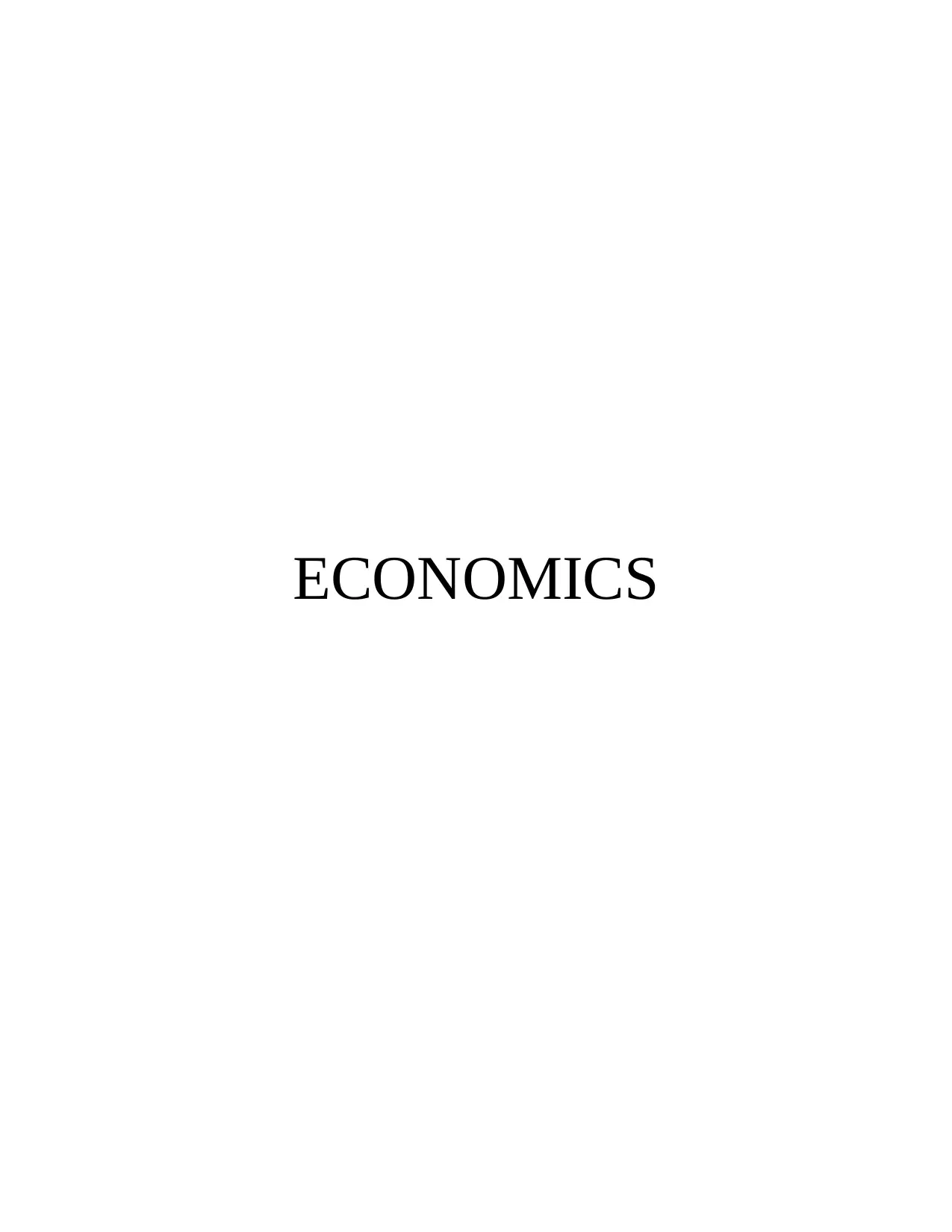
ECONOMICS
Paraphrase This Document
Need a fresh take? Get an instant paraphrase of this document with our AI Paraphraser
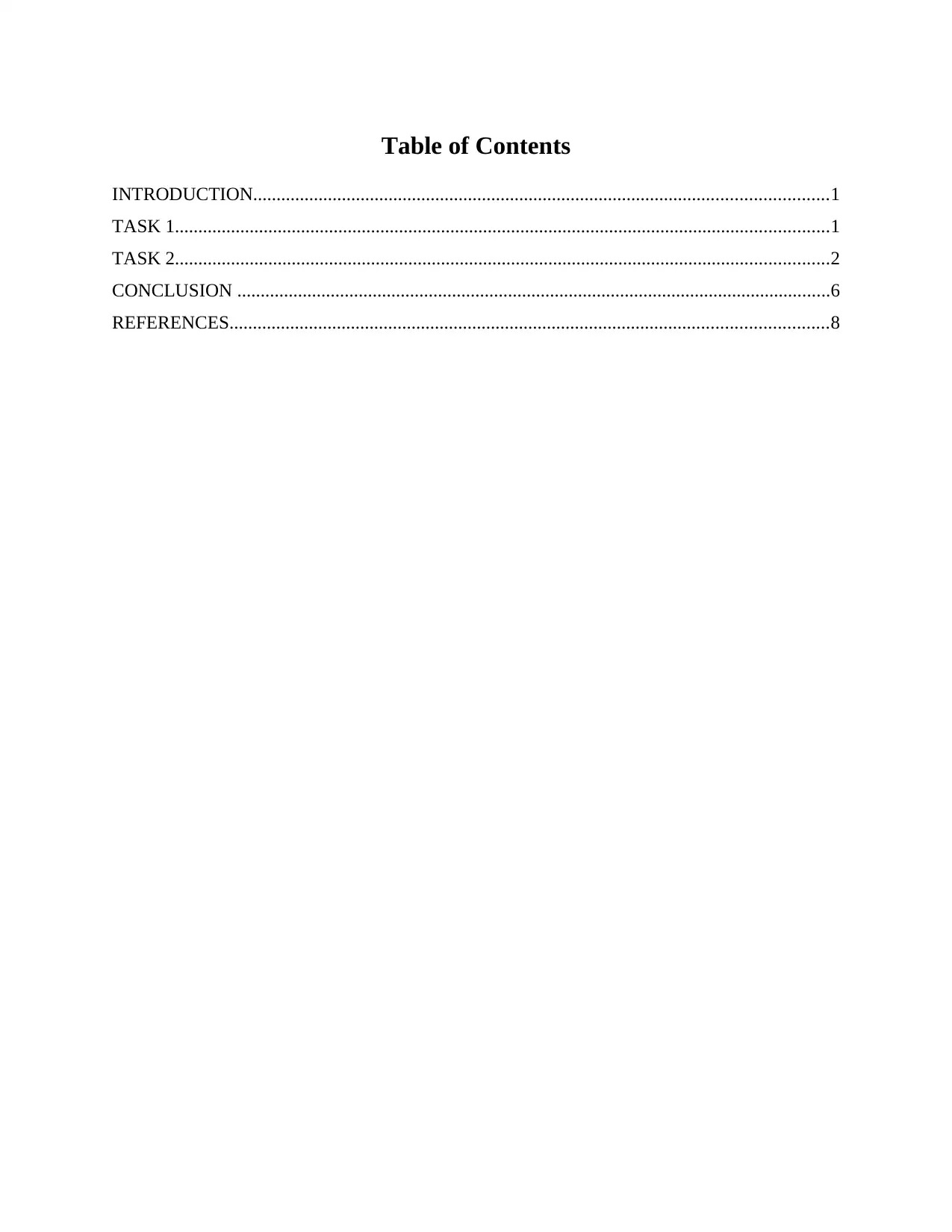
Table of Contents
INTRODUCTION...........................................................................................................................1
TASK 1............................................................................................................................................1
TASK 2............................................................................................................................................2
CONCLUSION ...............................................................................................................................6
REFERENCES................................................................................................................................8
INTRODUCTION...........................................................................................................................1
TASK 1............................................................................................................................................1
TASK 2............................................................................................................................................2
CONCLUSION ...............................................................................................................................6
REFERENCES................................................................................................................................8

Illustration Index
Illustration 1: Effect of change in quality of food............................................................................2
Illustration 2: Effect of change in supply.........................................................................................5
Illustration 3: Change in the prices of aluminium...........................................................................6
Illustration 1: Effect of change in quality of food............................................................................2
Illustration 2: Effect of change in supply.........................................................................................5
Illustration 3: Change in the prices of aluminium...........................................................................6
⊘ This is a preview!⊘
Do you want full access?
Subscribe today to unlock all pages.

Trusted by 1+ million students worldwide

INTRODUCTION
Economics is an important subject in order to study demand, supply consumption and
distribution of a particular product or services. The report discusses about the economical
concepts that can be applied on the question that 'Why airline food tastes so bad?'. The main
concepts such as availability of substitutes, cost benefit perspective principle, production cost
will be discussed. Further, the reason of increased prices of food provided in the airplane will
also be discussed. Moreover, the reasons of increase in the prices of the aluminium will be
focussed upon on the report. In the end, the major cause that is global economic crisis 2008 will
be mentioned to assess its impact.
TASK 1
Question: Why airline food tastes so bad?
The major complaint of every air traveller is that the taste of airline food is bad.
However, if the food with same taste is served as in a restaurant, then it will not be able to earn
any profits.
The main motive of every airline industry is to generate profits. The cost benefit
perspective principle of economics makes this concept clear. It helps in analysing the profits an
entity can generate with the cost incurred in it. If the profits earned in not higher up to a certain
level then the enterprise do not opt for any change in the existing strategy. It is difficult for the
airline industry to prepare food, 37000 feet above the ground level. It will cost 10 times to
produce the quality food in an airplane in comparison to a restaurant. Production of quality food
requires modern kitchen with all the equipment, recruit quality skilled chefs, arrange all the
ingredients. It would be very difficult to perform all the activities in a gallery of an airplane.
Further, the profits generated from the activity will not be able to cover up the cost incurred on
setting up of airline's kitchen. Therefore, the cost incurred in making quality food for the
customers is not affordable for the airline industry. Further, one of the main reason for degraded
food quality is scarcity of area in the airplane.
1
Economics is an important subject in order to study demand, supply consumption and
distribution of a particular product or services. The report discusses about the economical
concepts that can be applied on the question that 'Why airline food tastes so bad?'. The main
concepts such as availability of substitutes, cost benefit perspective principle, production cost
will be discussed. Further, the reason of increased prices of food provided in the airplane will
also be discussed. Moreover, the reasons of increase in the prices of the aluminium will be
focussed upon on the report. In the end, the major cause that is global economic crisis 2008 will
be mentioned to assess its impact.
TASK 1
Question: Why airline food tastes so bad?
The major complaint of every air traveller is that the taste of airline food is bad.
However, if the food with same taste is served as in a restaurant, then it will not be able to earn
any profits.
The main motive of every airline industry is to generate profits. The cost benefit
perspective principle of economics makes this concept clear. It helps in analysing the profits an
entity can generate with the cost incurred in it. If the profits earned in not higher up to a certain
level then the enterprise do not opt for any change in the existing strategy. It is difficult for the
airline industry to prepare food, 37000 feet above the ground level. It will cost 10 times to
produce the quality food in an airplane in comparison to a restaurant. Production of quality food
requires modern kitchen with all the equipment, recruit quality skilled chefs, arrange all the
ingredients. It would be very difficult to perform all the activities in a gallery of an airplane.
Further, the profits generated from the activity will not be able to cover up the cost incurred on
setting up of airline's kitchen. Therefore, the cost incurred in making quality food for the
customers is not affordable for the airline industry. Further, one of the main reason for degraded
food quality is scarcity of area in the airplane.
1
Paraphrase This Document
Need a fresh take? Get an instant paraphrase of this document with our AI Paraphraser

Another reason is non-availability of substitutes which makes the airline industry free to
keep any prices for the food and the quality as well. The passengers decide to board a flight
according to the price of the ticket and not depending upon the quality of food. Further, once the
passenger have boarded the flight he has to take whatever food are offered in the flight as they
have no other option or substitute available with them. Therefore, they do not give time and
efforts to improve the quality of food products.
The primary services of the airline sector is to provide best air transport services having
comfortable seating arrangement with fewer travelling time to customers and food comes as a
secondary service in order to support the primary one. Hence, the least emphasis is provided on
the secondary activity of airlines.
Airlines is a monopoly sector and fewer substitutes are available to the customers. The
prices of the flights as well as the services provided in it are decided by the management of the
company itself. They have all the rights to decide the prices of the flight tickets and food
provided in it. Quality of food and its prices are decided based on the cost incurred to prepare
that food and efforts that have been extended by the entity to make it available, 37000 feet above
the ground level.
TASK 2
The essay is related to the fluctuations in the prices of aluminium which happened to take
place in 2008. The essay discusses about the reasons affecting the prices of metal. It further
discusses about demand and supply relationship and availability of substitutes. Moreover, the
main reason that is fluctuation in the economy due to 2008 global crisis will also be discussed.
2
Illustration 1: Effect of change in quality of food
Source: Ehrenberg and Smith, 2016
keep any prices for the food and the quality as well. The passengers decide to board a flight
according to the price of the ticket and not depending upon the quality of food. Further, once the
passenger have boarded the flight he has to take whatever food are offered in the flight as they
have no other option or substitute available with them. Therefore, they do not give time and
efforts to improve the quality of food products.
The primary services of the airline sector is to provide best air transport services having
comfortable seating arrangement with fewer travelling time to customers and food comes as a
secondary service in order to support the primary one. Hence, the least emphasis is provided on
the secondary activity of airlines.
Airlines is a monopoly sector and fewer substitutes are available to the customers. The
prices of the flights as well as the services provided in it are decided by the management of the
company itself. They have all the rights to decide the prices of the flight tickets and food
provided in it. Quality of food and its prices are decided based on the cost incurred to prepare
that food and efforts that have been extended by the entity to make it available, 37000 feet above
the ground level.
TASK 2
The essay is related to the fluctuations in the prices of aluminium which happened to take
place in 2008. The essay discusses about the reasons affecting the prices of metal. It further
discusses about demand and supply relationship and availability of substitutes. Moreover, the
main reason that is fluctuation in the economy due to 2008 global crisis will also be discussed.
2
Illustration 1: Effect of change in quality of food
Source: Ehrenberg and Smith, 2016

Aluminium is metal which is relatively soft and lightweight. It is a good conductor of
heat and resistant to corrosion as well. It is an effective metal for varied industries such as,
transportation, construction, power etc. The metal is used to produce various things such as
almirah, kitchen utensils, window frames etc. which makes it useful in day to day activities as
well (Atkinson and Stiglitz, 2015).
There is a presence of various substitutes in the markets which makes it attracted towards
fluctuation in prices. The major substitutes of aluminium are, glass, paper, plastic and steel. Any
fluctuations in the prices of the substitutes leads to increase and decrease in the demands of
aluminium (Auerbach and et.al., 2013). For instance, if there is a rise in the prices of steel, it will
increase the demand of aluminium among the customers. However, if there is a significant fall in
the prices of the aluminium then the customers will tend to purchase it more and their preference
will change from steel to aluminium.
A decrease in the prices of the substitute goods reduces the need of aluminium. The main
substitutes such as, glass, steel, paper etc. can also be used by the consumers to produce utensils
and other products can be replaced from aluminium as raw material. However, there are some
industries where aluminium is the only core metal that can be used by them in order to produce
finished goods. One of the industry is auto mobile where aluminium is used to develop body of
the car and some of its motor parts as well (Bruneel and et.al., 2012).
Demand means number of customers who are willing to buy a particular product at a
particular price. Supply means the number of products that are available for the customer in the
market. Demand and supply help to understand the market in a better way. Additionally, it is an
indicator of elasticity and inelastic demand. Higher the price lower the quantity demanded and
vice versa. People forgo buying of a product leading to not consuming the product which falls in
high pricing category.
Elastic demand means a small change in the prices of the product lead to a large change
in the quantity demanded. However, as per inelastic demand there is no change experienced in
quantity demanded with the change in the prices. Further, it is important that how elastic a
product is in a particular period. Therefore, demand and supply is the another factor affecting the
prices of aluminium. It brings new equilibrium between price and quantity demanded. It also has
a great impact on the prices of the product as well. An increase in demand lead to change in
prices of the product as well.
3
heat and resistant to corrosion as well. It is an effective metal for varied industries such as,
transportation, construction, power etc. The metal is used to produce various things such as
almirah, kitchen utensils, window frames etc. which makes it useful in day to day activities as
well (Atkinson and Stiglitz, 2015).
There is a presence of various substitutes in the markets which makes it attracted towards
fluctuation in prices. The major substitutes of aluminium are, glass, paper, plastic and steel. Any
fluctuations in the prices of the substitutes leads to increase and decrease in the demands of
aluminium (Auerbach and et.al., 2013). For instance, if there is a rise in the prices of steel, it will
increase the demand of aluminium among the customers. However, if there is a significant fall in
the prices of the aluminium then the customers will tend to purchase it more and their preference
will change from steel to aluminium.
A decrease in the prices of the substitute goods reduces the need of aluminium. The main
substitutes such as, glass, steel, paper etc. can also be used by the consumers to produce utensils
and other products can be replaced from aluminium as raw material. However, there are some
industries where aluminium is the only core metal that can be used by them in order to produce
finished goods. One of the industry is auto mobile where aluminium is used to develop body of
the car and some of its motor parts as well (Bruneel and et.al., 2012).
Demand means number of customers who are willing to buy a particular product at a
particular price. Supply means the number of products that are available for the customer in the
market. Demand and supply help to understand the market in a better way. Additionally, it is an
indicator of elasticity and inelastic demand. Higher the price lower the quantity demanded and
vice versa. People forgo buying of a product leading to not consuming the product which falls in
high pricing category.
Elastic demand means a small change in the prices of the product lead to a large change
in the quantity demanded. However, as per inelastic demand there is no change experienced in
quantity demanded with the change in the prices. Further, it is important that how elastic a
product is in a particular period. Therefore, demand and supply is the another factor affecting the
prices of aluminium. It brings new equilibrium between price and quantity demanded. It also has
a great impact on the prices of the product as well. An increase in demand lead to change in
prices of the product as well.
3
⊘ This is a preview!⊘
Do you want full access?
Subscribe today to unlock all pages.

Trusted by 1+ million students worldwide
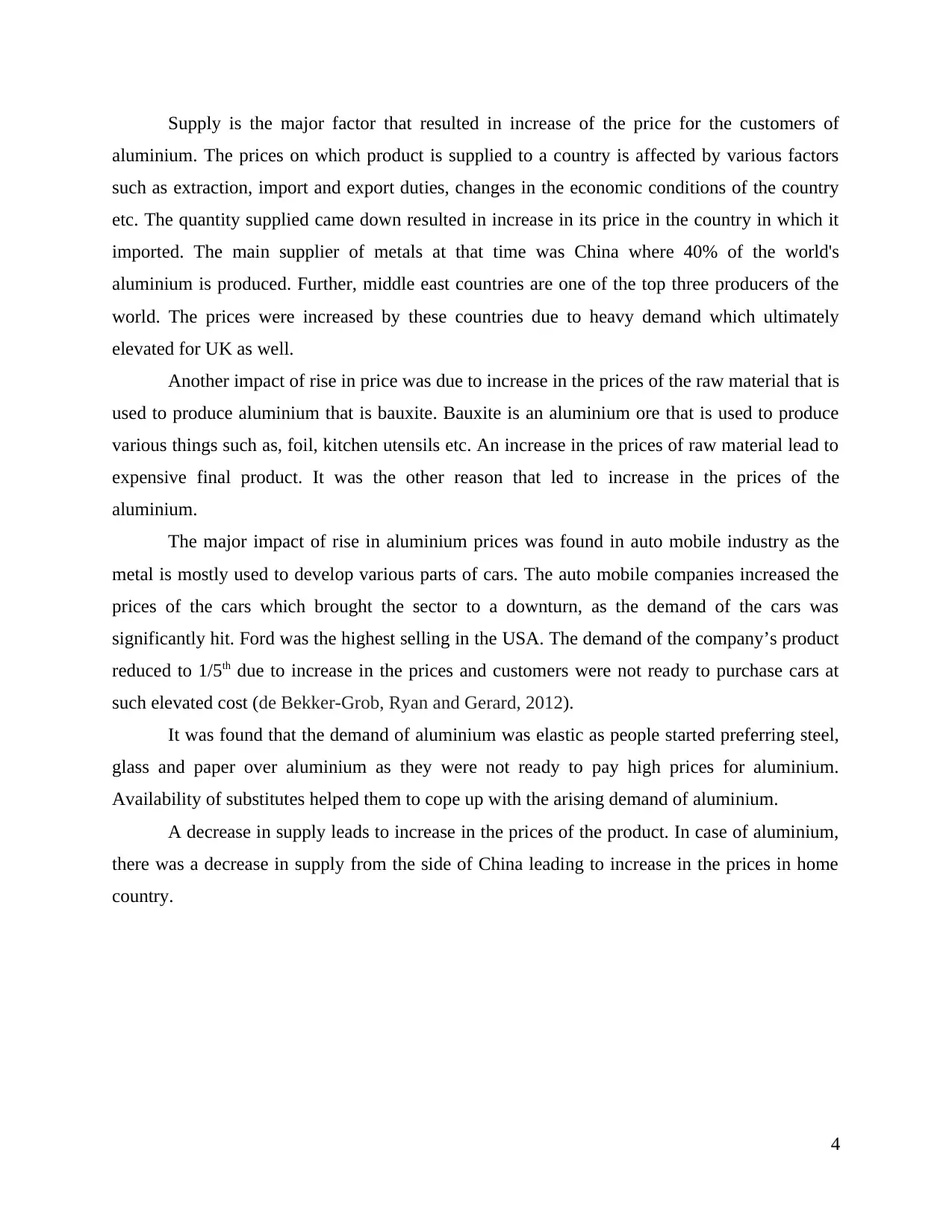
Supply is the major factor that resulted in increase of the price for the customers of
aluminium. The prices on which product is supplied to a country is affected by various factors
such as extraction, import and export duties, changes in the economic conditions of the country
etc. The quantity supplied came down resulted in increase in its price in the country in which it
imported. The main supplier of metals at that time was China where 40% of the world's
aluminium is produced. Further, middle east countries are one of the top three producers of the
world. The prices were increased by these countries due to heavy demand which ultimately
elevated for UK as well.
Another impact of rise in price was due to increase in the prices of the raw material that is
used to produce aluminium that is bauxite. Bauxite is an aluminium ore that is used to produce
various things such as, foil, kitchen utensils etc. An increase in the prices of raw material lead to
expensive final product. It was the other reason that led to increase in the prices of the
aluminium.
The major impact of rise in aluminium prices was found in auto mobile industry as the
metal is mostly used to develop various parts of cars. The auto mobile companies increased the
prices of the cars which brought the sector to a downturn, as the demand of the cars was
significantly hit. Ford was the highest selling in the USA. The demand of the company’s product
reduced to 1/5th due to increase in the prices and customers were not ready to purchase cars at
such elevated cost (de Bekker‐Grob, Ryan and Gerard, 2012).
It was found that the demand of aluminium was elastic as people started preferring steel,
glass and paper over aluminium as they were not ready to pay high prices for aluminium.
Availability of substitutes helped them to cope up with the arising demand of aluminium.
A decrease in supply leads to increase in the prices of the product. In case of aluminium,
there was a decrease in supply from the side of China leading to increase in the prices in home
country.
4
aluminium. The prices on which product is supplied to a country is affected by various factors
such as extraction, import and export duties, changes in the economic conditions of the country
etc. The quantity supplied came down resulted in increase in its price in the country in which it
imported. The main supplier of metals at that time was China where 40% of the world's
aluminium is produced. Further, middle east countries are one of the top three producers of the
world. The prices were increased by these countries due to heavy demand which ultimately
elevated for UK as well.
Another impact of rise in price was due to increase in the prices of the raw material that is
used to produce aluminium that is bauxite. Bauxite is an aluminium ore that is used to produce
various things such as, foil, kitchen utensils etc. An increase in the prices of raw material lead to
expensive final product. It was the other reason that led to increase in the prices of the
aluminium.
The major impact of rise in aluminium prices was found in auto mobile industry as the
metal is mostly used to develop various parts of cars. The auto mobile companies increased the
prices of the cars which brought the sector to a downturn, as the demand of the cars was
significantly hit. Ford was the highest selling in the USA. The demand of the company’s product
reduced to 1/5th due to increase in the prices and customers were not ready to purchase cars at
such elevated cost (de Bekker‐Grob, Ryan and Gerard, 2012).
It was found that the demand of aluminium was elastic as people started preferring steel,
glass and paper over aluminium as they were not ready to pay high prices for aluminium.
Availability of substitutes helped them to cope up with the arising demand of aluminium.
A decrease in supply leads to increase in the prices of the product. In case of aluminium,
there was a decrease in supply from the side of China leading to increase in the prices in home
country.
4
Paraphrase This Document
Need a fresh take? Get an instant paraphrase of this document with our AI Paraphraser
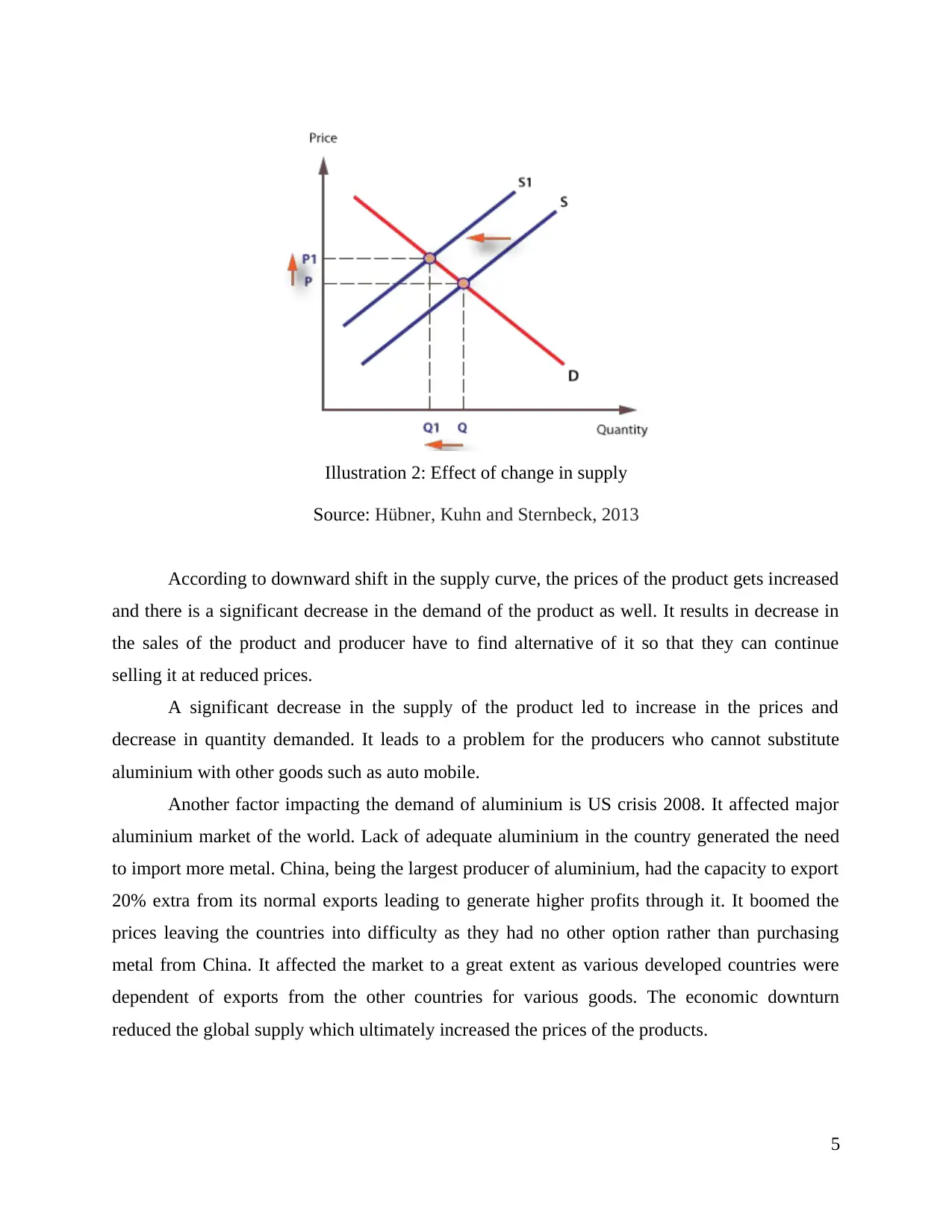
According to downward shift in the supply curve, the prices of the product gets increased
and there is a significant decrease in the demand of the product as well. It results in decrease in
the sales of the product and producer have to find alternative of it so that they can continue
selling it at reduced prices.
A significant decrease in the supply of the product led to increase in the prices and
decrease in quantity demanded. It leads to a problem for the producers who cannot substitute
aluminium with other goods such as auto mobile.
Another factor impacting the demand of aluminium is US crisis 2008. It affected major
aluminium market of the world. Lack of adequate aluminium in the country generated the need
to import more metal. China, being the largest producer of aluminium, had the capacity to export
20% extra from its normal exports leading to generate higher profits through it. It boomed the
prices leaving the countries into difficulty as they had no other option rather than purchasing
metal from China. It affected the market to a great extent as various developed countries were
dependent of exports from the other countries for various goods. The economic downturn
reduced the global supply which ultimately increased the prices of the products.
5
Illustration 2: Effect of change in supply
Source: Hübner, Kuhn and Sternbeck, 2013
and there is a significant decrease in the demand of the product as well. It results in decrease in
the sales of the product and producer have to find alternative of it so that they can continue
selling it at reduced prices.
A significant decrease in the supply of the product led to increase in the prices and
decrease in quantity demanded. It leads to a problem for the producers who cannot substitute
aluminium with other goods such as auto mobile.
Another factor impacting the demand of aluminium is US crisis 2008. It affected major
aluminium market of the world. Lack of adequate aluminium in the country generated the need
to import more metal. China, being the largest producer of aluminium, had the capacity to export
20% extra from its normal exports leading to generate higher profits through it. It boomed the
prices leaving the countries into difficulty as they had no other option rather than purchasing
metal from China. It affected the market to a great extent as various developed countries were
dependent of exports from the other countries for various goods. The economic downturn
reduced the global supply which ultimately increased the prices of the products.
5
Illustration 2: Effect of change in supply
Source: Hübner, Kuhn and Sternbeck, 2013
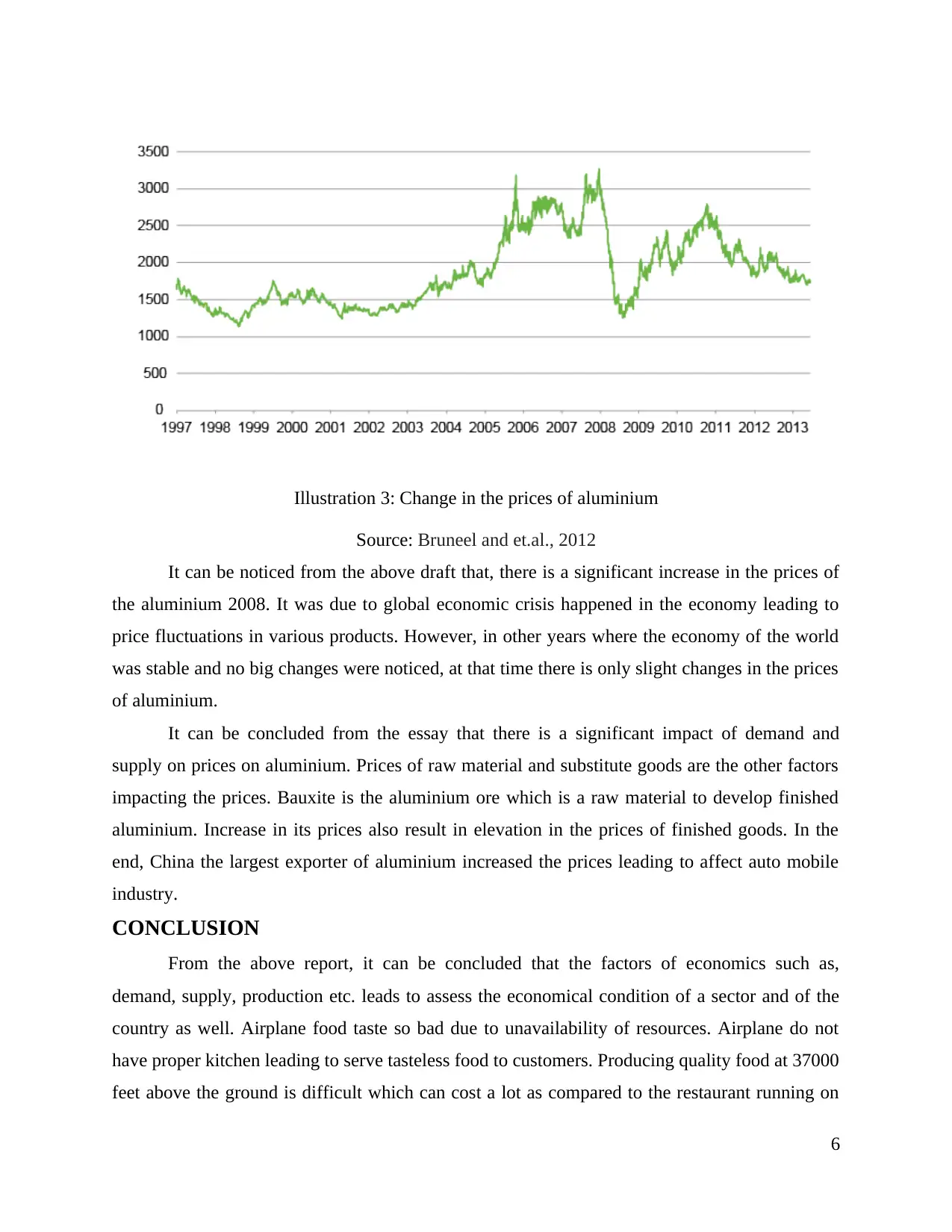
It can be noticed from the above draft that, there is a significant increase in the prices of
the aluminium 2008. It was due to global economic crisis happened in the economy leading to
price fluctuations in various products. However, in other years where the economy of the world
was stable and no big changes were noticed, at that time there is only slight changes in the prices
of aluminium.
It can be concluded from the essay that there is a significant impact of demand and
supply on prices on aluminium. Prices of raw material and substitute goods are the other factors
impacting the prices. Bauxite is the aluminium ore which is a raw material to develop finished
aluminium. Increase in its prices also result in elevation in the prices of finished goods. In the
end, China the largest exporter of aluminium increased the prices leading to affect auto mobile
industry.
CONCLUSION
From the above report, it can be concluded that the factors of economics such as,
demand, supply, production etc. leads to assess the economical condition of a sector and of the
country as well. Airplane food taste so bad due to unavailability of resources. Airplane do not
have proper kitchen leading to serve tasteless food to customers. Producing quality food at 37000
feet above the ground is difficult which can cost a lot as compared to the restaurant running on
6
Illustration 3: Change in the prices of aluminium
Source: Bruneel and et.al., 2012
the aluminium 2008. It was due to global economic crisis happened in the economy leading to
price fluctuations in various products. However, in other years where the economy of the world
was stable and no big changes were noticed, at that time there is only slight changes in the prices
of aluminium.
It can be concluded from the essay that there is a significant impact of demand and
supply on prices on aluminium. Prices of raw material and substitute goods are the other factors
impacting the prices. Bauxite is the aluminium ore which is a raw material to develop finished
aluminium. Increase in its prices also result in elevation in the prices of finished goods. In the
end, China the largest exporter of aluminium increased the prices leading to affect auto mobile
industry.
CONCLUSION
From the above report, it can be concluded that the factors of economics such as,
demand, supply, production etc. leads to assess the economical condition of a sector and of the
country as well. Airplane food taste so bad due to unavailability of resources. Airplane do not
have proper kitchen leading to serve tasteless food to customers. Producing quality food at 37000
feet above the ground is difficult which can cost a lot as compared to the restaurant running on
6
Illustration 3: Change in the prices of aluminium
Source: Bruneel and et.al., 2012
⊘ This is a preview!⊘
Do you want full access?
Subscribe today to unlock all pages.

Trusted by 1+ million students worldwide
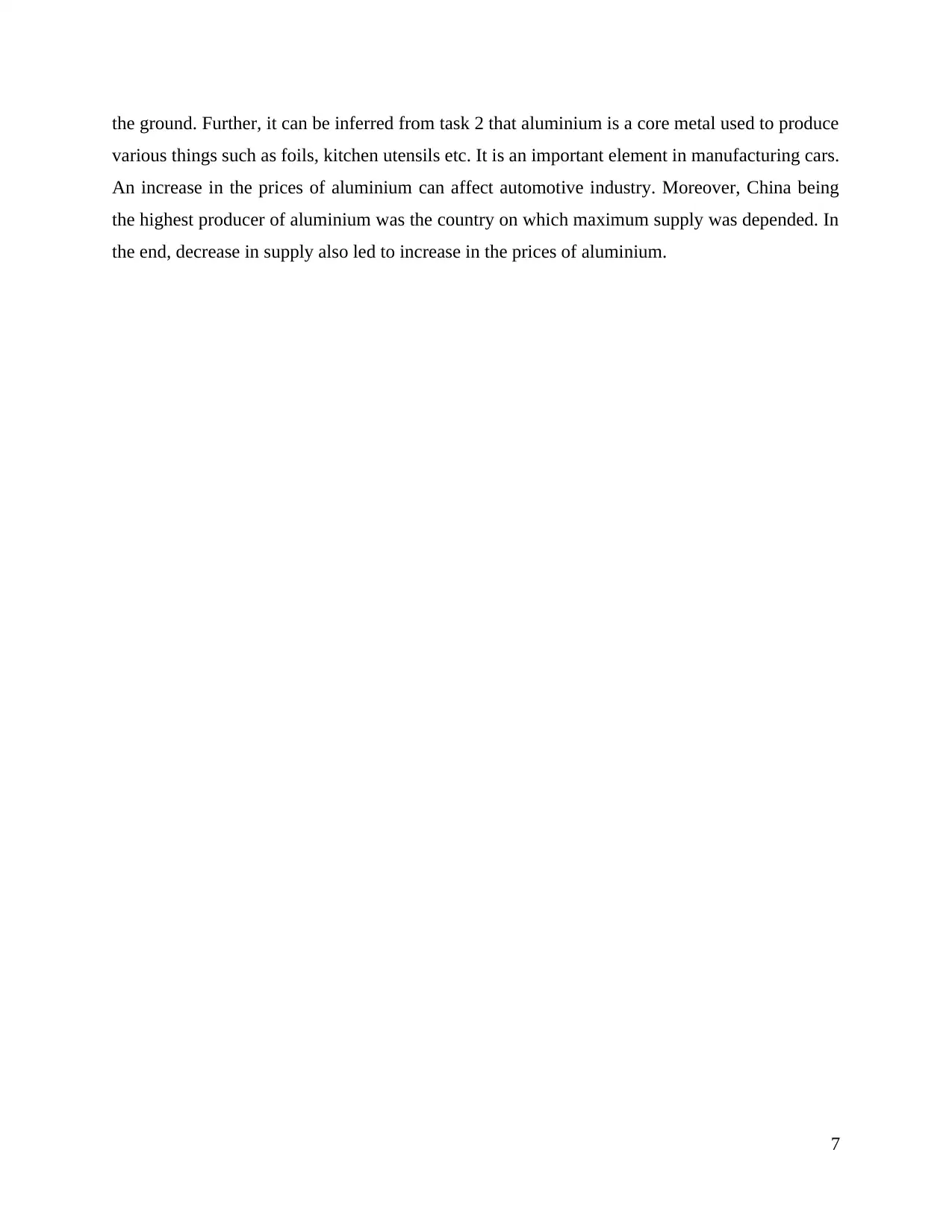
the ground. Further, it can be inferred from task 2 that aluminium is a core metal used to produce
various things such as foils, kitchen utensils etc. It is an important element in manufacturing cars.
An increase in the prices of aluminium can affect automotive industry. Moreover, China being
the highest producer of aluminium was the country on which maximum supply was depended. In
the end, decrease in supply also led to increase in the prices of aluminium.
7
various things such as foils, kitchen utensils etc. It is an important element in manufacturing cars.
An increase in the prices of aluminium can affect automotive industry. Moreover, China being
the highest producer of aluminium was the country on which maximum supply was depended. In
the end, decrease in supply also led to increase in the prices of aluminium.
7
Paraphrase This Document
Need a fresh take? Get an instant paraphrase of this document with our AI Paraphraser
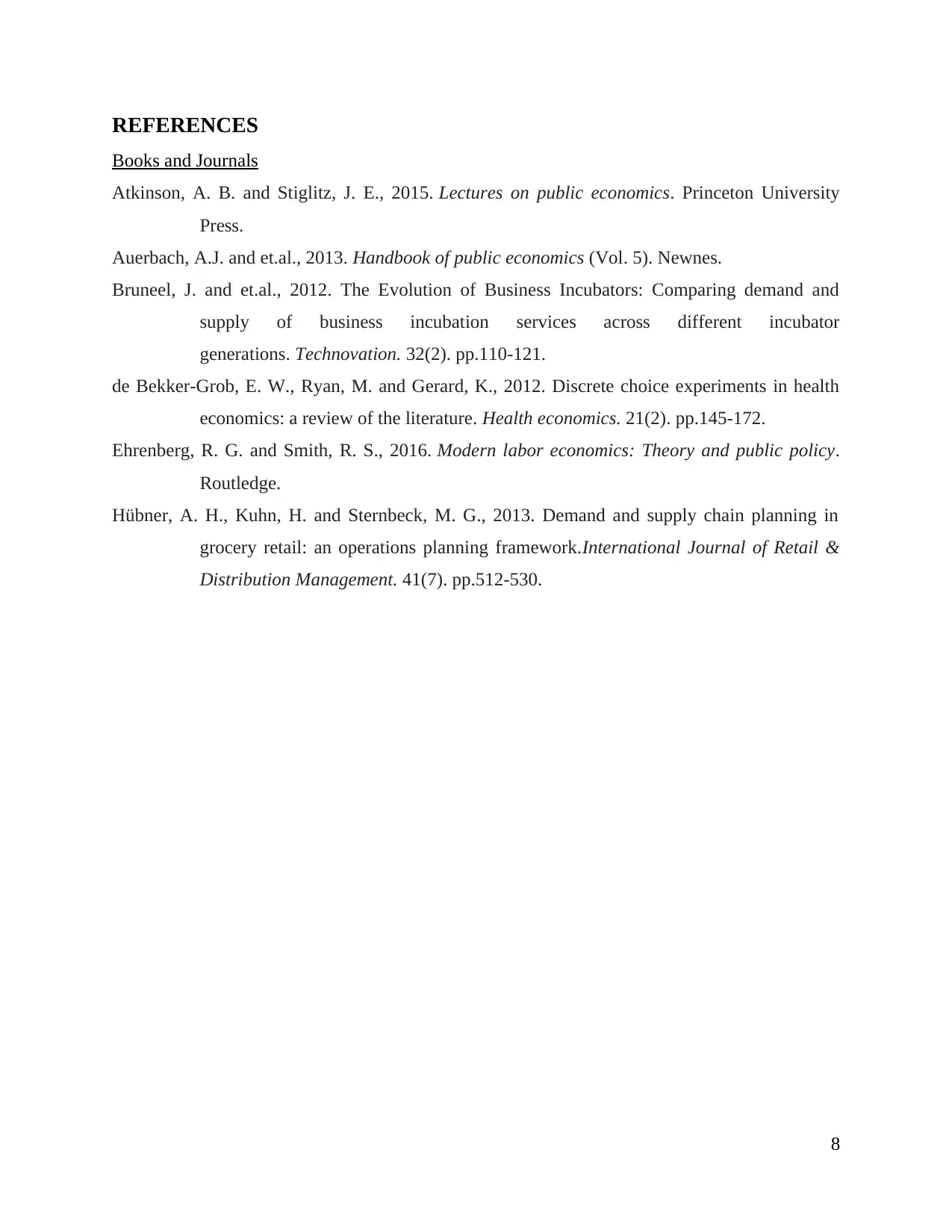
REFERENCES
Books and Journals
Atkinson, A. B. and Stiglitz, J. E., 2015. Lectures on public economics. Princeton University
Press.
Auerbach, A.J. and et.al., 2013. Handbook of public economics (Vol. 5). Newnes.
Bruneel, J. and et.al., 2012. The Evolution of Business Incubators: Comparing demand and
supply of business incubation services across different incubator
generations. Technovation. 32(2). pp.110-121.
de Bekker‐Grob, E. W., Ryan, M. and Gerard, K., 2012. Discrete choice experiments in health
economics: a review of the literature. Health economics. 21(2). pp.145-172.
Ehrenberg, R. G. and Smith, R. S., 2016. Modern labor economics: Theory and public policy.
Routledge.
Hübner, A. H., Kuhn, H. and Sternbeck, M. G., 2013. Demand and supply chain planning in
grocery retail: an operations planning framework.International Journal of Retail &
Distribution Management. 41(7). pp.512-530.
8
Books and Journals
Atkinson, A. B. and Stiglitz, J. E., 2015. Lectures on public economics. Princeton University
Press.
Auerbach, A.J. and et.al., 2013. Handbook of public economics (Vol. 5). Newnes.
Bruneel, J. and et.al., 2012. The Evolution of Business Incubators: Comparing demand and
supply of business incubation services across different incubator
generations. Technovation. 32(2). pp.110-121.
de Bekker‐Grob, E. W., Ryan, M. and Gerard, K., 2012. Discrete choice experiments in health
economics: a review of the literature. Health economics. 21(2). pp.145-172.
Ehrenberg, R. G. and Smith, R. S., 2016. Modern labor economics: Theory and public policy.
Routledge.
Hübner, A. H., Kuhn, H. and Sternbeck, M. G., 2013. Demand and supply chain planning in
grocery retail: an operations planning framework.International Journal of Retail &
Distribution Management. 41(7). pp.512-530.
8
1 out of 11
Related Documents
Your All-in-One AI-Powered Toolkit for Academic Success.
+13062052269
info@desklib.com
Available 24*7 on WhatsApp / Email
![[object Object]](/_next/static/media/star-bottom.7253800d.svg)
Unlock your academic potential
Copyright © 2020–2025 A2Z Services. All Rights Reserved. Developed and managed by ZUCOL.





